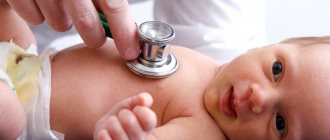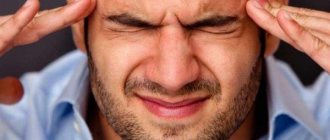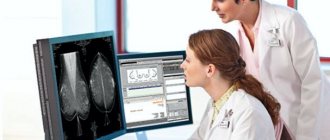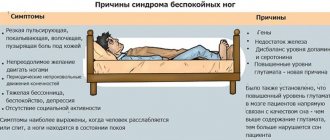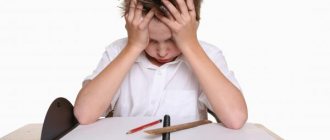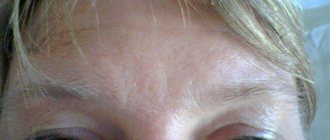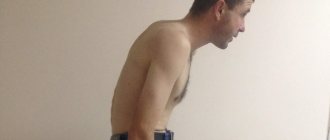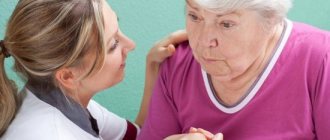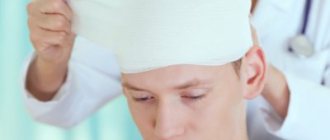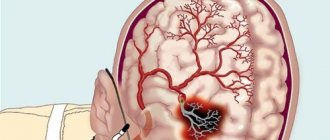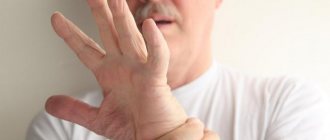Vestibulo-atactic syndrome is a disorder that occurs against the background of a disorder in the functioning of the body’s vascular system. The pathological process begins with subtle symptoms, which progress over time and lead to serious disorders of motor functions.
This pathology is a whole complex of motor and coordination disorders caused by impaired general blood circulation in the brain. This disorder is characterized by a sudden loss of balance, poor stability while walking and even standing, and falls.
This pathology is not an independent disease. Manifestations of the syndrome are the result of more severe illnesses. More often it occurs due to ischemia - a chronic circulatory disorder of the brain.
Sometimes dizziness and motor dysfunction can be manifestations not only of the pathology itself, but also of irreversible changes in the functions of the musculoskeletal and vestibular system that occur due to old age.
Risk factors
Risk factors include:
- Birth trauma in newborns.
- Various skull injuries.
- Complex infectious diseases.
- Acute or chronic drug intoxication.
- Increased background radiation.
- Lack of vitamins and microelements in the body.
- Bad habits.
- Heredity.
As you can see, vestibulo atactic syndrome accompanies many diseases, so it should not be underestimated. The symptoms of this pathology are a consequence of more serious diseases associated with brain dysfunction, which in advanced forms lead to disability and even death.
Changes in the motor functions of the body are associated with age-related disorders of the functioning of the musculoskeletal and vestibular apparatus
Restoration of the vestibular system, speech and memory
It is very important that the rehabilitation process proceeds correctly, according to the scheme prescribed by the doctor. Only in this case can bad consequences be avoided.
A stroke often leads to problems with speech - a person has difficulty expressing his own thoughts and understanding other people. It may take up to three years for activity to return. That is why communication between the patient and his relatives and friends, interaction with other patients is so important. To make rehabilitation go faster, it is recommended:
- ask the patient simple questions that require a “yes” or “no” answer;
- pronounce words slowly;
- actively engage with a person, teaching him sounds.
There are several effective exercises that can help after a stroke. These include:
- Speaking tongue twisters.
- Licking the lips, and the patient needs to move the tongue left and right while doing this.
- Baring teeth.
- Soft biting of lips.
- Stretching out the tongue with a short delay for 5 seconds, frequent repetitions of this exercise.
The sooner you start memory restoration, the faster you can achieve results - you can begin procedures immediately after doctors eliminate the threat to life. The first stage can be called taking special medications, which must be prescribed by a doctor. Such means include:
- Drugs that dilate blood vessels, for example Vasobral.
- Alpha blockers.
- Tranquilizers and nootropics.
It is worth remembering that such drugs have a slow effect, so in any case you need to take a course, which can last up to three months. When taking them, you should carefully monitor the patient's condition to ensure that the stroke does not recur.
Functional treatment is also important, for example, brain training: memorizing numbers, poems, and other information.
Reasons for development
How does vestibulo-atactic syndrome manifest? Chronic circulatory failure of acquired or congenital form occurs in the vertebrobasilar arterial layers.
In addition, the phenomenon of vestibular-atactic syndrome is associated with changes in frontal stem cells, normal pressure hydrocephalus, cortical atrophy, hypertension, atherosclerosis, and osteochondrosis.
The immediate causes of motor and coordination problems are:
- chronic circulatory failure (ischemia);
- cerebellar dysfunction;
- frontal pathology;
It cannot be considered as an independent disease. The disorder is always a consequence of more serious pathologies - most often ischemia (chronic anemia) of the brain.
In some cases, dizziness and impaired motor function are signs of natural age-related disorders associated with the functioning of the musculoskeletal and vestibular system.
Severity
The severity of symptoms varies from mild to moderate to severe.
Each stage of vestibuloatactic syndrome is characterized by corresponding motor and coordination problems.
A mild form of vestibuloatactic syndrome is characterized by a weak degree of ataxia (motor dysfunction. It is manifested by a change in gait, deterioration in coordination of movements.
The moderate stage is characterized by headaches and vestibular dysfunction (nausea, instability when walking).
In the severe stage, critical problems arise related to movement, standing, and even the impossibility of moving independently.
An invariable companion of ischemia is headache. The most unpleasant and unpredictable neuropathic pain.
Symptoms
What are the signs, symptoms, and complaints of patients that will allow diagnosing ataxia?
Ischemic disorders are dangerous because in the early stages they are simply not noticed, since the first symptoms that appear correspond to various health problems and conditions. A person simply does not pay attention to individual cases of illness.
This makes it difficult to timely diagnose and treat diseases that are associated with vestibulo-atactic syndrome.
The first signs of the initial stage of the disease are:
- Frequent dizziness, especially when walking.
- Flickering and “flies” before the eyes.
- Nausea, vomiting.
- Headache.
- In later stages, movement disorders appear:
- Loss of balance.
- Throwing from side to side.
- Involuntary twitching of eyelids
In addition, many people complain about:
- Deterioration in the quantity and quality of sleep.
- Chronic fatigue, loss of strength.
- Noise, ringing in the ears.
Unpleasant sensations when maintaining the same body position for a long time.
Additional manifestations are sleep disturbances, tinnitus, decreased performance, and rapid fatigue.
Cephalgic syndrome
Cephalgic vestibuloatactic syndrome, in other words headache, is a health disorder that not only brings discomfort to our lives, but can also serve as a warning signal of more serious disorders of the body's functioning, such as diseases of the brain and central nervous system.
The growing prevalence of this condition, both among the adult population and among children and adolescents, is causing concern among doctors.
Cephalgia is perhaps the most common symptom and sign of many pathological conditions of the brain. Its appearance is associated with oncological, inflammatory, infectious diseases, metabolic disorders, vascular, and neuralgic problems. Even the presence of bad habits and violation of the daily routine can provoke acute cephalgic syndrome .
The many causes of the disorder make it difficult to diagnose cephalgia as a symptom of a specific disease. Elimination of headaches should be one of the stages of treatment of the disease caused by it, and not a separate process.
Cephalgic syndrome appears as a result of ordinary nervous tension, fatigue, or as one of the main symptoms of vestibulo-atactic syndrome associated with serious brain diseases. Therefore, it is necessary to take responsibly any of its manifestations in order to protect yourself from the development of severe forms of the disease with irreversible neuro-psychological processes.
Discirculatory encephalopathy with vestibulo-atactic syndrome
Vestibulo-atactic syndrome may be a harbinger of such a serious disease as dyscirculatory encephalopathy.
The brain is the main organ of the central nervous system, which is responsible for the vital functions of the body and controls its functioning. Consists of nerve cells that perform different functions, responsible for certain actions, such as speech, thinking, movement, memory.
For normal functioning of the brain, oxygen is needed, which helps break down glucose and produce the energy necessary for work. With insufficient oxygen consumption supplied by the blood stream, the toxic effects of certain substances on the cells, nerve cells begin to die, causing certain disorders, depending on which part is affected.
Such disorders are called encephalopathy. The most common form is dyscirculatory encephalopathy with vestibulo-atactic syndrome, which in the last three stages of the disease leads to severe impairments of memory, intelligence, and thinking in general (dementia).
Possible complications
Lack of timely treatment, an incorrect diagnosis, or a medical error made during the formation of a therapeutic course can lead to the development of the following complications and negative consequences for the health and life of a patient with vestibulopathic disorder:
- development of ischemic cerebral vascular disease, if it was not yet present at the time of the onset of musculoskeletal dysfunction;
- inability to lead a full and active lifestyle;
- complete or partial loss of ability to work;
- cerebral stroke;
- atherosclerosis of blood vessels supplying brain tissue;
- the development of dementia, which can occur in a person of any age group;
- disability, dependence on the help of loved ones, bedridden or wheelchair-bound;
- physical inability to service one’s own physiological needs;
- the development of a mental disorder that occurs against the background of depletion of the cerebral cortex and degenerative processes in its tissues.
Vestibulopathic disorder, which is a chronic syndrome of cerebrovascular accidents, is a dangerous pathological condition of brain tissue.
The disease leads to disruption of the musculoskeletal system, lack of normal coordination of the upper and lower extremities, which is especially pronounced during walking. Timely drug treatment and physiotherapeutic procedures can prevent the progression of the syndrome and maintain the patient’s quality of life.
Article design: Vladimir the Great
Diagnosis of vestibulo-atactic syndrome
Diagnosis of vestibulo-atactic syndrome includes numerous examinations of the body, aimed not only at confirming the vestibular disorder, but also at identifying the possible cause of the syndrome itself and concomitant diseases.
Find out more Frontal Lobe Syndrome
For an accurate and correct diagnosis, differential diagnostics is used, which, in addition to collecting an anamnesis, a neurological examination of the patient taking into account his complaints, includes laboratory and instrumental research methods.
Laboratory tests for suspected vestibular ataxia:
- Blood test for biochemistry;
- General urine analysis;
- Biopsy of cerebrospinal fluid.
A clearer picture of the disease is provided by instrumental research, consisting of:
- Magnetic resonance imaging (MRI), computed tomography (CT), detect tumors in the brain
- Electroencephalography to determine bioelectrical activity
- Echoencephalography, which allows you to determine the state of the cerebrospinal fluid system and detect objects such as hematoma, tumor, brain abscess.
- Rheoencephalography helps to assess the condition of blood vessels and blood circulation in them.
- Renography of the skull and spine.
Additional information about the severity of the disease can be obtained using rapid diagnostics:
- Romberg sample for assessing cerebellar function and static ataxia.
The patient becomes in the correct position: legs together, arms forward. He will be asked to close his eyes. If a person begins to stagger and loses balance, this indicates certain dysfunctions of the cerebellar functions.
- Test palm
It is suggested to close your eyes and alternately reach the tip of your nose with the index fingers of both hands. The presence of vestibulo-atactic syndrome is determined by trembling in the hands and inaccurate hits.
- Knee joint test
From the supine position, you are asked to lift one leg and touch the knee of the other leg, then lower the leg, passing the heel along the shin of the other leg.
Damage to the cerebellum, which is responsible for coordination and balance, causes difficulty performing this task.
The diagnosis is made by a specialist doctor or a board of doctors based on research.
Signs of vestibular ataxia
The main symptoms of vestibular ataxia are nystagmus, nausea and vomiting, dizziness, and various types of autonomic abnormalities. Ataxia manifests itself both in movement and while standing, when a person does not perform any manipulations. A distinctive feature of the disorder is that its manifestations depend on the movement of the head and torso.
As a result of vestibular ataxia, a person is deprived of the ability to fully move and perform basic actions, and if the need arises, he has to turn extremely slowly so as not to cause discomfort. When closing the eyes, the patient feels even more insecure, and visual control alleviates the symptoms while the movement is being made.
In most cases, the vestibular apparatus has unilateral damage, which is why the disease is characterized by an unsteady gait and a constant tilt of the body in the same direction. As a rule, the side to which the body deviates is the side where the vestibular apparatus is affected.
Vestibular ataxia may be accompanied by systemic dizziness. This sensation of smooth rotation of one’s own body, which can haunt the patient not only when moving, but also when standing and even sitting with his eyes closed. Systemic dizziness may be accompanied by nausea and vomiting, redness or, conversely, paleness of the face, and disturbances in the rhythm of the heartbeat and pulse. Often the patient feels fear and anxiety.
Nystagmus is most often observed in a horizontal position of the body. With horizontal nystagmus, the direction of deviation of the eyeball is opposite to the side of the lesion of the vestibular apparatus. Vertical nystagmus may also be observed, by which it is not possible to identify the side of the lesion. Increased nystagmus when moving or tilting the head indicates disturbances in the periphery of the vestibular apparatus.
Treatment
Treatment of vestibulo-atactic syndrome is carried out on the basis of a diagnostic examination. It's not just drugs and physical therapy. To get good results in treating the disorder, patients are advised to reconsider their attitude towards the health problem, lead a healthy lifestyle, give up bad habits and follow a nutritious diet.
Since one of the main causes of vestibular disorders is high blood pressure, the first stage of therapy is to reduce blood cholesterol levels (statins - atoriz, rosuvastatin) and blood pressure (hypertensive drugs - captopril, enalapril).
Priority in the treatment of vestibulo-atactic syndrome is given to the following drugs:
Actovegin
Produced in the following forms:
- Solution for injection – ampoules of 2 ml, 5 ml and 10 ml.
- Solution for infusion – 250 mg bottle.
- Tablets – 200 mg.
Actovegin is recommended to be used orally, 1-2 tablets. Three times a day before meals, without chewing, with a small amount of water.
The initial recommended injection dose is 10-20 ml. Depends on the severity of the disease. Then, the dosage is reduced to 5 ml once a day or several times a week.
For a dropper, use 250 ml of solution for infusion at a rate of 2-3 ml per minute once a day (10-20 droppers per course).
Precautions : It is not advisable to use the drug during pregnancy and breastfeeding.
When injected, there is a risk of angioedema.
Adverse reactions : urticaria in the form of itching, redness of the skin, hyperhidrosis (excessive sweating), mild chills, fever.
Mildronate
Produced in forms:
- Solution for injection – 5 ml ampoules.
- Capsules (tablets) – 250 mg, 500 mg.
For chronic disease, 0.5-1 g (1-2 tablets of 500 mg or 2-4 tablets of 250 mg) per day for 4-6 weeks.
In the acute phase - 0.5 g intravenously once a day for 10 days.
Not recommended for use during pregnancy and nursing mothers. Used with caution in pathological conditions of the liver and kidneys. Contraindicated in children under 18 years of age, people with increased intracranial hypertension, intracranial neoplasms, and venous outflow.
Should be taken with caution in combination with other medications as it tends to enhance the effects of many of them.
Side effects : Does not cause life-threatening adverse reactions.
Sometimes allergic reactions, changes in blood pressure, agitation, increased heart rate, dyspepsia: heartburn, belching, diarrhea occur.
Mexidol
Produced in forms:
- Solution for injection – 2 ml, 5 ml
- Tablets 125 mg
Mexidol is taken orally, one or two tablets three times a day, for 2-6 weeks.
The injection drug is administered at a dose of 0.1 g, 1-3 times a day, gradually increasing the dosage. Maximum 0.8 g.
Precautions: The drug is contraindicated in the presence of an allergy to vitamin B6, in children, during pregnancy, breastfeeding, in case of serious functional impairment, organic damage to the liver, kidneys.
An overdose causes drowsiness and affects the reaction speed.
Side effects : allergic reactions of varying intensity are possible, skin reactions in the form of rash, itching, weeping skin, nausea, vomiting, and a feeling of dry mouth.
In general, the drug is well tolerated by most patients.
In addition, sometimes prescribed:
Cavinton
- Tablets – 5 mg, 10 mg.
Cavinton for this pathology is taken orally 5 mg (1 tablet of 5 mg or ½ tablet of 10 mg) 2-3 times a day, 1-8 weeks.
Contraindicated during pregnancy and breastfeeding. Not recommended for hypersensitivity to components, acute phase of cerebral hemorrhage, severe ischemic heart disease (unstable angina), cardiac rhythm conduction disturbances (arrhythmias).
Cavinton affects the reaction rate.
Adverse reactions: tachycardia, cardiac dysfunction, slight pallor of the skin, signs of allergies (itching, redness), impaired sleep quality (insomnia, night terrors), dizziness, low-intensity headache, migraine attacks, hyperhidrosis, fatigue, weakness, nausea, sometimes vomiting, heartburn, dry mouth.
Trental
Release forms:
- Solution for injection – 5 ml ampoule.
- Tablets – 100 mg.
Mode of application:
- Droppers – 100-600 mg once or twice a day.
- Intravenous injection 100 mg once or twice daily. The patient should be in a horizontal position.
Take two or four tablets orally 2-3 times a day after meals, without chewing, with water.
Precautions : it is contraindicated to use trental during pregnancy, breastfeeding, gastric and duodenal ulcers, a tendency to gastrointestinal hemorrhages, strokes of various origins, retinal hemorrhages.
Find out more Ataxic syndrome in children: symptoms
Used with caution in severe forms of cardiovascular pathological conditions, a tendency to sudden changes in blood pressure, stomach ulcers, and in the postoperative period.
Side effects : usually well tolerated by patients. Sometimes the following disorders occur: nausea, sometimes the urge to vomit, bowel disorders (constipation or diarrhea), decreased blood pressure, palpitations, headache, migraine attacks, dizziness, irritability, emotional instability, sleep disorders (insomnia, nightmares), allergic skin reactions in the form of hyperemia, skin itching, Quincke angioedema.
Complex therapy recommends the use of: vitamins, microelements, for example, from the Vitrum series.
Physiotherapeutic treatment usually complements medication and includes medicinal baths, massage, therapeutic exercises, oxygen therapy and other procedures as prescribed. Sometimes acupuncture and hypnosis are used.
Conservative therapy
For this purpose, special drugs are prescribed to reduce cholesterol levels, such as statins, as well as a diet.
A healthy lifestyle will play a very important role in the treatment of pathology. The patient needs to give up bad habits and adhere to the correct daily routine.
Further therapy will depend on the established cause of the syndrome and the severity of its manifestations. To eliminate this pathology, it is necessary, first of all, to get rid of the main causes that led to this condition.
If the disorder occurs against the background of ischemic disease, drug therapy is prescribed using the following drugs:
- Mildronate - improves oxygen cellular nutrition and metabolic processes;
- Actovegin is a stronger drug;
- Mexidol - has an antioxidant effect and also reduces cholesterol levels;
- Trental, Cavinton, Instenon - means for stimulating blood circulation in the brain;
- antidepressants of the benzodiazepine group - used in cases of more severe ischemia.
Favorable results can be achieved with complex treatment. In addition to taking a course of medications, the patient is prescribed physical therapy, which includes:
- special therapeutic exercises;
- acupuncture;
- acupressure head massage;
- herbal medicine.
An unconventional method such as hypnosis has proven itself quite well.
Alternative Treatment
Alternative treatment for vestibulo-atactic syndrome is carried out in conjunction with medication. Let's consider several recipes that will help eliminate the main symptoms of the disease:
To dilute the blood and increase blood flow in the vessels of the brain, use garlic.
Peel large heads of garlic and chop in a meat grinder. Place in a cool, dark place for 3 days. Take a 1:1:1 mixture with honey, lemon juice. 1 tbsp. spoon before bed.
With high blood pressure
Mix corn silk (40 g) and lemon balm (20 g) with lemon juice, pour in 1 liter of boiling water. Leave for 1 hour.
Strain, take half a glass 3 times a day, half an hour after meals.
Improve blood circulation
Mix ½ kg cranberries, 150 g finely grated horseradish, 350 g honey. Take 2 teaspoons every day. After meals, drink tea or water.
Clean the vessels
1 tbsp. pour a spoonful of juniper berries with 200 g of boiled water at room temperature. Leave for 8-10 hours. Take 1 tbsp. spoon 3-4 times a day. The course is 1.5-2 months.
Herbal treatment gives good results in the treatment of vestibulo-atactic syndrome. Alternative medicine doctors offer several recipes:
For dizziness, tinnitus
Mix equal parts of thyme, motherwort, mint, and cucumber herbs. Pour 450 g of boiling water, leave for 2 hours. Strain thoroughly and take ½ glass 2 times a day after meals.
Exercises for the eyes and head
With flat feet, important functions of the foot are lost. Possible shocks and shocks when moving are not softened, and the vibration spreads throughout the body, which is harmful. Anatomically, the foot has three arches, which are strengthened by ligaments and muscles. The outer arch serves as a support, the inner arch acts as a spring, the transverse arch softens blows and shocks.
The correct formation of the foot depends not only on the relative position of the bones, but also on the condition of the ligaments and the work of the muscles of the lower leg. The arch is finally formed by 3-4 years. Until this time, the child’s foot seems completely flat. Early detection of the disease will help prevent the development of the disease and strengthen the baby’s legs.
At the same time, you should not shackle his legs with tight and tight sliders or socks. In childhood, it is contraindicated to wear hard shoes. The development of organs and systems, muscles and ligaments, strengthening the immune system is promoted by therapeutic exercises, swimming, and massage.
Parents should monitor how the child places his feet when moving. Up to 2 years of age, it is considered normal for the baby to spread his legs wide apart to increase the area of support. Next, he needs to be taught the correct gait. The exercise “Walking on a log” or along a path 15 cm wide is suitable for this. You can draw a path with chalk on the asphalt and invite the child to walk along it without stepping on the edges.
Therapeutic gymnastics can also include the “Teddy Bear” exercise - walking on the inside and outside of the foot. In the summer, it is very useful to run barefoot on warm sand, pebbles, and earth. To carry out therapeutic exercises at home in winter, you can pour the same pebbles and sand into a box. To prevent flat feet, walking on a ribbed, gable path is useful.
To develop the muscles of the foot, you can grab small objects or fabric (handkerchief, sock) from the floor with your toes. The exercise is performed both sitting and standing. The child should be asked to pick up a pencil or pen and hold the object for a while. The formation of the correct position of the foot is facilitated by sitting “Turkish style”.
You can also ask the child to learn how to get up from this position. It is recommended to change the position of your legs when lifting to distribute the load on each foot. Squats, walking on tiptoes - all this is also included in therapeutic exercises aimed at combating flat feet. It is recommended to carry out the exercises in a playful way so that the child finds it interesting.
Vestibulopathy is an imaginary sensation of movement of the patient’s body and surrounding objects. In the treatment of this disease, I actively use medications that reduce nausea, improve the conduction of nerve impulses, as well as other groups of drugs.
The main stage of rehabilitation measures is considered to be vestibular exercises for dizziness. It has a very wide range of exercises that, when performed regularly, have a positive effect. The first exercises for the treatment of vestibulopathies were developed in the 40s of the last century by T. Cawthorne and F. Cooksey. Today, many types of tasks are taken from this complex.
Special gymnastics for dizziness is an effective way to normalize the condition
Gymnastics for the vestibular apparatus for dizziness should begin as early as possible. Patients can do exercises after the first signs of improvement. Physical therapy is indicated during drug treatment. The function of the vestibular organ is restored much faster if the patient constantly stimulates it with various movements.
Scientists and doctors have conducted research on the effect of physical exercise on restoring the functioning of the vestibular system. It has been proven that with regular exercise, 50-80% of patients experience positive dynamics. At the same time, in a third of patients the balance apparatus was completely restored.
Exercises should be as varied as possible, since the vestibular apparatus quickly adapts to the load. The patient constantly needs to complicate tasks so that the receptors of the balance apparatus are constantly in good shape. This helps to quickly restore neural connections between the brain and the auditory organ.
The gymnastics complex should be adapted for patients with vestibulopathies. The selection of exercises depends on the severity of the disease. In many patients, the balance apparatus is severely damaged. This increases the risk of falls during exercise. Patients are allowed to train with their eyes open and perform tasks with support. Bedridden patients after a stroke undergo physical therapy (physical therapy) in bed, helping them to rise and sit down.
When performing exercises to train the vestibular apparatus for dizziness, stressful situations and overwork should be excluded. It has been scientifically proven that anxiety and depression slow down rehabilitation measures. Patients with depression show signs of vestibulopathies for a long time, even after a long recovery period.
Drugs for the treatment of dizziness
When prescribing a set of exercises, the effect of medications should be taken into account. Some medications improve the functioning of the balance organ. These drugs include Betaserk, Tanakan. Studies were conducted on the effectiveness of Tanakan in a clinic setting on patients with primary vestibulopathies.
Drugs that inhibit the restoration of vestibular function are: antipsychotics, sedatives, tranquilizers. During the rehabilitation of vestibulopathies, patients are tried to stop these medications. If you stop taking neurotropic drugs, the effect of treatment is much higher.
Homeopathy
In case of intolerance to synthetic drugs and various contraindications, homeopathy comes to the rescue. Homeopathic medicines have shown good effectiveness:
Golden iodine
Dosage: 5 granules twice a day under the tongue 20 minutes before meals or one hour after meals for 2 months.
Precautions : Golden iodine is contraindicated in case of individual hypersensitivity to the components of the drug, pregnancy and breastfeeding. It is not advisable to give to children.
Side effects : Sometimes allergic reactions occur: skin rash, itching sensation.
Hypertensin
Take the drug five granules in the morning and evening half an hour before meals.
In acute cases, three to five granules every 10-15 minutes.
Precautions: Contraindicated in those with hypersensitivity to the drug.
No side effects were identified.
Venartin
The usual dose is 7 granules 2-3 times a day under the tongue half an hour before meals.
The course of treatment is 1 month, repeated after 1-2 weeks.
Precautions : Should not be combined with food consumption, various teas, including herbal, nicotine, alcohol, camphor-menthol preparations and oil-based essential oils.
There are no side effects.
Tanakan is a drug based on ginkgo biloba.
Dosage:
- Take one tablet three times a day with food and water.
- One dose solution three times a day with meals, previously dissolved in 0.5 tbsp. water.
- Course duration is 1-3 months.
Precautions: Contraindicated in children under 18 years of age, used only for those with individual indications.
Not used during pregnancy, breastfeeding, with peptic ulcer disease, erosive gastritis, lactose intolerance, acute myocardial infarction, unstable angina, reduced blood coagulation.
Do not use simultaneously with Warfarin and aspirin.
Side effects : possible allergic reactions, reduced blood clotting, gastrointestinal bleeding, eczema, digestive disorders (dyspepsia), diarrhea, constipation, nausea, sometimes vomiting, headaches, migraine attacks, tinnitus, dizziness.
If the proposed methods do not bring the desired results, surgical treatment is prescribed. Surgery on the vertebral artery is performed by doctors of the highest category, since it is a complex surgical procedure. However, it is low traumatic and gives good results. The operation itself, when performed correctly, is quite safe and has a high degree of effectiveness (about 70%).
Other methods
In combination with drug treatment of vestibulopathic syndrome, the following physiotherapeutic techniques are used, which improve cerebral circulation, stimulate the central nervous system and prevent the development of atherosclerosis of small arterioles and arteries:
- therapeutic massage of the cervical spine and occipital lobe of the head, which is performed daily for 20 minutes;
- acupuncture of sensitive points of the body that are responsible for the functioning of the cerebellum and vestibular apparatus (the procedure is performed by a specialized specialist in the sterile conditions of a doctor’s office);
- therapeutic exercises, which includes performing rotational movements of the head to ensure a flow of additional blood volume to the occipital lobes of the brain (types of exercises are selected individually by a neurologist depending on the stage of the vestibulopathic syndrome);
- contrast shower, which is taken in the morning and evening for 10 minutes. with a sharp change of hot and cold water, improves general and cerebral circulation, increases the functionality of the central nervous system.
In addition to the above physiotherapeutic methods, the most radical method of treatment can be used.
This is a surgical intervention aimed at providing additional blood flow to the brain tissue. The operation is performed on the vertebral artery. The surgeon crosses the vasomotor fibers, which provide resistance to the flow of the bloodstream.
Surgical intervention requires high qualifications and skill of the surgeon who treats the patient. A positive therapeutic effect is achieved in 70% of cases. Surgical treatment of vestibulopathic syndrome is advisable at stages 1 and 2 of the disease, when there are still no signs of irreversible changes in the brain tissue.
Prevention
How to protect yourself from vestibulo-atactic syndrome? Preventive measures aimed at preventing the development of cerebral ischemia.
This disease leads not only to impaired motor coordination, but also to other problems - cephalgic syndrome, in which a person experiences a constant severe headache, amostatic syndrome associated with movement disorders, pseudobulbar, which negatively affects all basic body functions.
Patients predisposed to vascular disorders, especially those at risk of ageing, should be attentive to their health and undergo regular medical examinations.
From an early age, it is necessary to adhere to the basic criteria of a healthy lifestyle: avoid excessive emotional stress and stressful situations; refrain from drinking alcohol, coffee, quit smoking;
At the first signs of ischemia, it is necessary to reduce the intensity of physical activity, especially related to weight lifting; Avoid prolonged exposure to sunlight.
Other important preventive measures are the fight against obesity and lack of exercise. For diseases such as diabetes, hypertension, atherosclerosis, it is necessary to follow all therapeutic recommendations of doctors. Physiotherapy is carried out exclusively by medical specialists.
Vestibulo-ataxic disorder requires timely and mandatory referral to a doctor for diagnosis and appropriate therapy. Ignoring or refusing this is unacceptable.
If you notice the first signs of impaired motor coordination or other accompanying symptoms, do not delay your visit to the clinic.
Additional complications of the pathology include spasmodic phenomena in the vessels of the brain.
Useful exercises
- Head tilts. The head is tilted as far down as possible, then the chin is lifted up. They also tilt their head alternately to the right and left, bringing the ear closer to the shoulder. The shoulders should be lowered. At the end point, the movements freeze for several seconds.
- Turn your head.
Turn your head as far as possible to the right and left, freezing at the end point for several seconds. - Moving the head forward. Pull your chin forward as much as possible and freeze for a few seconds. The head should not rise or fall.
- Semicircle.
Draw a semicircle with your chin from one shoulder to the other and back. Then they tilt their head back and draw a semicircle with the back of their head. - Head rotation. Rotate your head first clockwise, then counterclockwise. You need to rotate calmly, slowly, making sure you don’t get dizzy.
- Incline.
They lower their chin down, close their eyes, put their hands on the back of their heads and relax. The weight of your arms should stretch your neck muscles.
Many people find it very difficult to change their lifestyle.
Changes in your life should be introduced gradually: try to limit the consumption of fatty foods, increase the content of fruits and vegetables in your diet, take nightly walks in the fresh air and do physical exercises in the morning, enroll in some kind of sports section.
Once you start accustoming yourself to a healthy lifestyle, your well-being will change. The body reacts very quickly to changing habits. The patient will experience constant headaches and weakness, and will feel an influx of strength. Your health will improve every day, and this will encourage you to make more and more improvements. Not only will the symptoms of the pathology decrease and disappear, but the quality of life will also improve.


